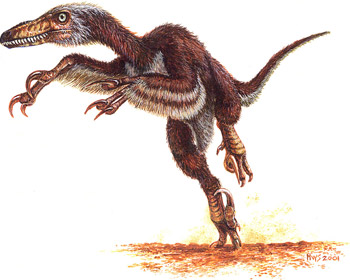
My favorite movie is "Jurassic Park". That's not the fun fact, but it does pertain to the fun fact. You see, in this fantastic and wondrous film, some of the more threatening dinosaurs terrorizing the humans on Isla Nublar are the Velociraptors, lethal pack hunters which systematically and awesomely hunt down their prey. I must inform you, however regrettably, that the movie is in fact in error on several of the things about Velociraptors, both from exaggeration and now-outdated information:
Here are said errors:
- The size of the animals. This is a rather complicated mix up, actually.
 You see, in actuality, Velociraptor mongoliensis was only around three feet tall, not nearly the size of the 6-7 foot animals in the film. However, this seems to stem from a genus mix-up. You see, Velociraptors belong to a group of dinosaurs called Dromaeosaurids, which are all characterized by stiff tails, long snouts, and lengthy/curved claws on the feet. Now, one such species of dromaeosaurid is Deinonychus antirrhopus, which meets the size and approximate physical features of the animals in the movie.
You see, in actuality, Velociraptor mongoliensis was only around three feet tall, not nearly the size of the 6-7 foot animals in the film. However, this seems to stem from a genus mix-up. You see, Velociraptors belong to a group of dinosaurs called Dromaeosaurids, which are all characterized by stiff tails, long snouts, and lengthy/curved claws on the feet. Now, one such species of dromaeosaurid is Deinonychus antirrhopus, which meets the size and approximate physical features of the animals in the movie. However, the animals in the movie are called velociraptors, but in the novel, they are specifically called Velociraptor antirrhopus. Thus, they had the same species name as Deinonychus, but a different genus name. This means that it is likely that the author/filmmakers were using "Velociraptor" as a genus name for a different species, now known as Deinonychus, and were not referring to the singular species of Velociraptor now accepted, which is only 3 feet tall.
However, the animals in the movie are called velociraptors, but in the novel, they are specifically called Velociraptor antirrhopus. Thus, they had the same species name as Deinonychus, but a different genus name. This means that it is likely that the author/filmmakers were using "Velociraptor" as a genus name for a different species, now known as Deinonychus, and were not referring to the singular species of Velociraptor now accepted, which is only 3 feet tall. - The location of the fossils. In the film, early on, the paleontologists are shown unearthing a new "Velociraptor"(Deinonychus) fossil skeleton in Montana. However, velociraptor actually was found exclusively in areas of Mongolia, while only Deinonychus and Dromaeosaurus were found in North America in the Cretaceous period.
- Lastly, the dinosaurs in the film were lacking one feature that they now are known to possess: feathers.
 Discoveries of impressions in the rock surrounding well-preserved specimens of several dromaeosaurids show that they did indeed have feathers coating their bodies, perhaps used for insulation, or as a sort of membrane to trap prey beneath. But hey, these are newer finds, so "Jurassic Park" can't be blamed.
Discoveries of impressions in the rock surrounding well-preserved specimens of several dromaeosaurids show that they did indeed have feathers coating their bodies, perhaps used for insulation, or as a sort of membrane to trap prey beneath. But hey, these are newer finds, so "Jurassic Park" can't be blamed.
No comments:
Post a Comment